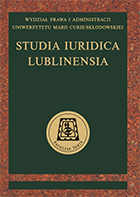Ustrój sądowy Prus, II Rzeszy i Republiki Weimarskiej (1815–1871 i 1918–1933)
Judicial System of Prussia, the Second Reich and the Weimar Republic (1815–1871 and 1918–1933)
Author(s): Tadeusz MaciejewskiSubject(s): History of Law, Public Administration, 18th Century, 19th Century, Pre-WW I & WW I (1900 -1919), Interwar Period (1920 - 1939)
Published by: Wydawnictwo Naukowe Uniwersytetu Marii Curie-Sklodowskiej
Keywords: Prussia; II Reich; Weimar Republic; judicial system;
Summary/Abstract: In the late 18th and 19th centuries, Prussia has initiated a change in the system of courts of general jurisdiction. The final separation of the judiciary from the administration was their first result. Furthermore, there was a gradual elimination of the patrimonial courts and separate municipal courts. The ultimate goal was to adapt the organization of the judiciary to the division of the country, while creating exclusive judicial system of the state. The Royal Decree of 1849 and subsequent laws from 1851 to 1852, which together have put uniform system of common courts in Prussia brought the new system of Prussian justice. The new organization of the judiciary, already for the Second Reich was composed of official courts, national courts operating in regions, and the Court of the Reich, based in Leipzig. In addition to courts of law, the courts and the special offices functioned, often associated with them, both in the Second Reich and the Weimar Republic. Almost each of the analyzed courts and the offices of the Second Reich, and later the Weimar Republic, was indirectly connected to the administrative judiciary. It occurred, at the same time, only in its most important federal states, e.g. Prussia, Bavaria, Saxony.
Journal: Studia Iuridica Lublinensia
- Issue Year: 25/2016
- Issue No: 3
- Page Range: 587-597
- Page Count: 11
- Language: Polish

